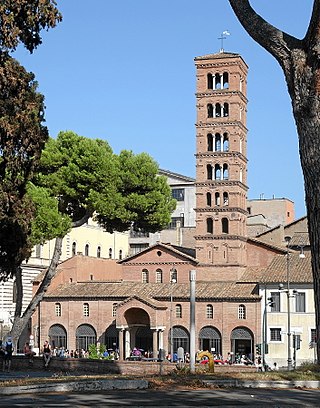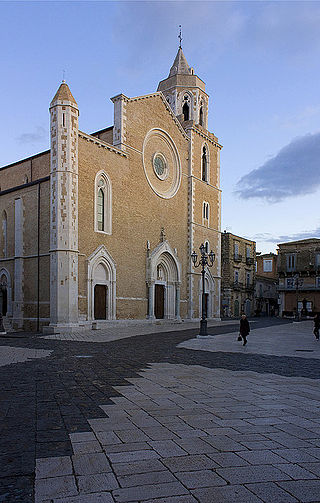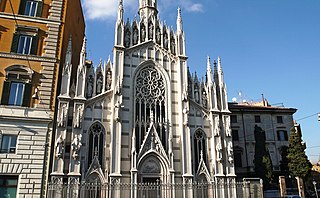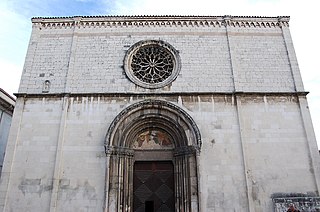
The Church of the Gesù is the mother church of the Society of Jesus (Jesuits), a Catholic religious order. Officially named Chiesa del Santissimo Nome di Gesù, its façade is "the first truly baroque façade", introducing the baroque style into architecture. The church served as a model for innumerable Jesuit churches all over the world, especially in the central Europe and then in the Portuguese colonies. Its paintings in the nave, crossing, and side chapels became models for Jesuit churches throughout Italy and Europe, as well as those of other orders. The Church of the Gesù is located in the Piazza del Gesù in Rome.

The Basilica of Saint Mary in Cosmedin is a minor basilican church in Rome, Italy, dedicated to the Virgin Mary. It is located in the rione (neighborhood) of Ripa. Constructed first in the sixth century as a diaconia (deaconry) in an area of the city populated by Greek immigrants, it celebrated Eastern rites and currently serves the Melkite Greek Catholic community of Rome. The church was expanded in the eighth century and renovated in the twelfth century, when a campanile was added. A Baroque facade and interior refurbishment of 1718 were removed in 1894-99; the exterior was restored to twelfth-century form, while the architecture of the interior recalls the eighth century with twelfth-century furnishings. The narthex of the church contains the famous Bocca della Verità sculpture.

Pisa Cathedral is a medieval Catholic cathedral dedicated to the Assumption of the Virgin Mary, in the Piazza dei Miracoli in Pisa, Italy, the oldest of the three structures in the plaza followed by the Pisa Baptistry and the Campanile known as the Leaning Tower of Pisa. The cathedral is a notable example of Romanesque architecture, in particular the style known as Pisan Romanesque. Consecrated in 1118, it is the seat of the Archbishop of Pisa. Construction began in 1063 and was completed in 1092. Additional enlargements and a new facade were built in the 12th century and the roof was replaced after damage from a fire in 1595.

Santa Maria del Carmine is a church in Pavia, Lombardy, northern Italy, considered amongst the best examples of Lombard Gothic architecture. It was begun in 1374 by Gian Galeazzo Visconti, Duke of Milan, on a project attributed to Bernardo da Venezia. The construction followed a slow pace, and was restarted in 1432, being finished in 1461.

The church of Santa Maria Assunta, known as I Gesuiti, is a religious building in Venice, Italy. It is located in the sestiere of Cannaregio, in Campo dei Gesuiti, not far from the Fondamenta Nuove.

Santa Maria della Pieve is a church in Arezzo, Tuscany, central Italy.

Lucera Cathedral is the cathedral of Lucera, Apulia, Italy. The dedication is to the Assumption of the Virgin Mary but it is also popularly known as Santa Maria della Vittoria from the statue of the Madonna kept here. It is the seat of the Bishop of Lucera-Troia, and is also a minor basilica. In its present form it originates mostly from the 14th century. It is one of the very few buildings in Apulia in which the Gothic architectural style of the medieval French rulers appears almost unaltered.

Santa Sofia is a Roman catholic church located in the Piazza of Anacapri, on the island of Capri, Italy. It dates to 1596 when it replaced Chiesa di Santa Maria di Costantinopoli as the parish church. Some of the building materials and fittings, such as the sacristy and oratorio, were originally in the Chiesa di San Carlo. The church chapels are dedicated to Sant'Antonio, Anacapri's patron saint, and the Madonna del Buon Consiglio. Architectural features include two bell towers and a baroque facade. The wedding of Guiliana DePandi and Bill Rancic occurred at the Chiesa di Santa Sofia.

Sacro Cuore di Gesù in Prati, also known as Sacro Cuore del Suffragio, is a catholic church in the centre of Rome (Italy), rising in the rione Prati, hosting the parish with the same name, entrusted to the Missionaries of the Sacred Heart.

Santa Maria Maggiore is an ancient Romanesque basilica church located at the foot of Colle di San Pietro in Tuscania, Province of Viterbo, Region of Lazio, Italy. Atop the hill is the Basilica of San Pietro.

The Basilica of Santa Maria Assunta is a 14th-century basilica in Alcamo, province of Trapani, Sicily, southern Italy. It is named after the Assumption.

Santa Maria dei Servi, or simply known as the Chiesa dei Servi, or more fully as the Church of the Nativity of the Servants of the Blessed Virgin Mary, is a 14th-century, Roman Catholic church that faces the Via Roma in Padua, region of the Veneto, Italy. This is a parish church in the vicariate of the Cathedral Basilica of Santa Maria Assunta governed by the Servite Order. The church contains outstanding works of art including a wooden crucifix by Donatello.

Oratorio di San Pellegrino is a medieval oratory in the village of Bominaco, in the municipality of Caporciano in the Province of L'Aquila (Abruzzo). The interior walls of the church are entirely covered in frescoes that represent a historical testimony of medieval Abruzzo. In 1902, the oratory was declared a national monument.

Chiesa di Santa Maria in Valle Porclaneta is a Romanesque church in Rosciolo dei Marsi, in western Abruzzo, central Italy.

Chiesa di Santa Giusta is a Romanesque church in L'Aquila (Abruzzo).

Chiesa di Santa Maria ad Cryptas is a Middle Ages church in Fossa, Province of L'Aquila (Abruzzo).

The Church of Santa Maria Maggiore is an important place of worship in the city of Trento, and the site of the Third Session of the Council of Trent. It was built by Antonio Medaglia on the model of the basilica of Sant'Andrea in Mantua, at the wish of the Prince-Archbishop Bernardo Clesio. In November 1973 Pope Paul VI accorded it the status of minor cathedral.

The Basilica of Santa Maria del Canneto, or Santa Maria Formosa, was a sixth-century Byzantine church erected in Pola under the patronage of Maximianus, bishop of Ravenna. The structure was damaged at the time of the Venetian sack of Pola in 1243, and building material was subsequently taken from the ruins and primarily incorporated into the Marciana Library and the Basilica of Saint Mark in Venice. Of the large, triple-nave church, comparable in splendour to the Euphrasian Basilica in Parenzo, only one of the lateral chapels survives. It constitutes the sole construction in Pola dating to the Byzantine period.

The parish church of San Giorgio di Valpolicella, also known as the parish church of San Giorgio Ingannapoltron, is an ancient Catholic place of worship located in San Giorgio di Valpolicella, a hamlet of Sant'Ambrogio di Valpolicella, in the province and diocese of Verona; it is also the seat of the parish of the same name included in the vicariate of Valpolicella.

Gaeta Cathedral, more formally the Cathedral of Saints Erasmus and Marcian and St. Mary of the Assumption, is the most important place of Catholic worship in Gaeta, Italy, mother church of the archdiocese of the same name and seat of the parish of Mary Most Holy Assumed into Heaven.
































